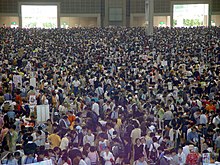Comic Market
The Comiket ( Jap.コミックマーケットkomikku māketto , abbreviated or colloquiallyコミケットkomiketto or international Comiket ) is the largest manganese trade fair and - Convention of Japan . It takes place every year in August and December for three days in the Tokyo district of Odaiba at the Big Sight exhibition center.
development
The Comic Market was founded in 1976 by students Teruo Harada, Jun Aniwa and Yoshihiro Yonezawa in protest against what they believed to be a poorly organized manga event, Nihon Manga Taikai . The first event had around 70 visitors. By the 80s, the non-commercial fair grew to become the most influential event in the emerging otaku culture. Then the commercial publishers presented themselves at the fair. The 72nd Comic Market in August 2007 attracted around 550,000 visitors, 35,000 exhibitors and 12,500 cosplayers in three days. The 89th Comiket in December 2015 attracted 520,000 visitors, 35,000 exhibitors and 29,000 cosplayers over the three days.
offer
The focus of the Comic Market is on the sale of self-drawn fan mangas, the dōjinshi , mostly self-published by the participants who work together in a group (called a circle). Even Cosplay and stalls of Anime Studios have a permanent place at the fair. However, the circles are not distributed randomly over the exhibition area, but rather form daily and local thematic focuses, so that circles with the same manga or topic as the basis are in closer proximity to each other.
The first day of the fair is dedicated to anime, manga and science fiction for the general audience. The topics of the second day are characters from computer games and Shōnen-ai . The last day is dedicated to serious study of the media and the erotic offerings for men.
Catalog
In order to make it easier for visitors to find their way around the exhibition halls, a catalog will be sold in the trade a few weeks in advance as a print version and on DVD-ROM. Since Comiket 83, the catalog can also be viewed online free of charge. The printed version is about the size and scope of the telephone directory of a big city and contains mainly exhibitor lists sorted by time, place and topic as well as further information about the fair. The catalog was once used to allow visitors to enter the event, but this is no longer necessary today. However, without a catalog it is very difficult to find your way around the exhibition halls.
meaning
There are no Western-style anime conventions in Japan . For most Japanese manga fans, the Comic Market is one of the most important events in their hobby. The event is the largest public exhibition in Japan and one of the largest cultural events in the country. Numerous well-known manga artists have started their careers as dōjinshi artists on the Comic Market. B. Masamune Shirow , Kenichi Sonoda and the CLAMP drawing team .
swell
- ↑ a b c Paul Gravett: Manga - 60 Years of Japanese Comics. Egmont Manga and Anime, 2006. pp. 135 f.
- ↑ コ ミ ッ ク マ ー ケ ッ ト 72 ア フ タ ー レ ポ ー ト
- ↑ コ ミ ッ ク マ ー ケ ッ ト 89 ア フ タ ー レ ポ ー ト
- ↑ While exhibitors and cosplayers need to register in advance, visitors who come on several days can also be counted several times.
- ↑ ロ グ イ ン | Comike Web Catalog
literature
- Fan-Yi Lam: Comic Market: How the World's Biggest Amateur Comic Fair Shaped Japanese Dōjinshi Culture . In: Mechademia 5 , 2010. pp. 232-248.
Web links
- Official Homepage - Japanese and English
- Photo report from the 69th Comic Market in December 2005 ( Memento from March 17, 2011 in the Internet Archive ) - English

